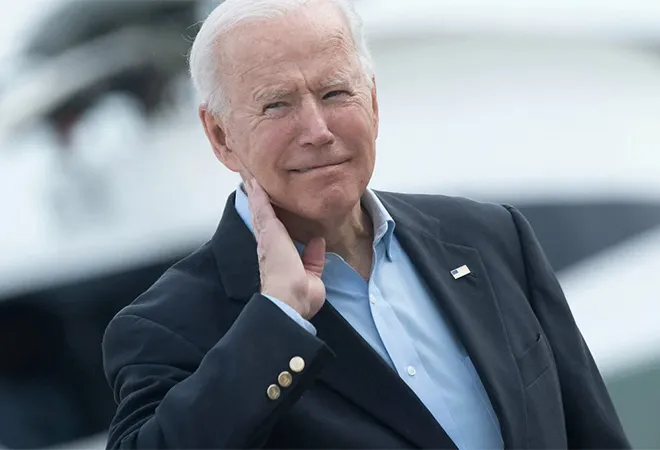
For most of President Biden’s term until now, the observers of the US-China relationship keenly awaited his administration’s policy towards China. Many thought that the United States (US) Secretary of State Antony Blinken’s
speech at the George Washington University in May 2022 outlined the Biden administration’s policy approach to China—pegged on three key strategic pillars: Invest, align, and compete. However, the repercussions of the recently concluded visit by Nancy Pelosi to Taiwan and China’s retributive policy retaliations could change the anticipated course of US-China relations that Biden sought to mould, for the worse.
Framing a sound China policy has been the proverbial albatross around President Biden’s neck from the first day. The Taiwan issue is now at the centre of that dilemma. Inheriting the legacy of a hostile US-China relationship from his predecessor and the political compulsion to carve a distinct China policy which is not concessional to Beijing have kept the Biden administration torn. Despite this, the Biden administration has tried to test China on Taiwan by adopting a strategy which has maintained the “One China Policy” on paper but pushed the envelope on the ground and in rhetoric. The culmination of this dual approach has resulted in the recent visit of US House Speaker Nancy Pelosi to China despite dire warnings from Beijing. As the anticipation around the unannounced visit of Nancy Pelosi built up, China had cautioned the US not to “play with fire,” referring to the planned visit. Similar tenor and language were used by China during Biden-Xi’s
meeting in November last year.
Inheriting the legacy of a hostile US-China relationship from his predecessor and the political compulsion to carve a distinct China policy which is not concessional to Beijing have kept the Biden administration torn.
The Biden administration’s China policy has witnessed several readjustments, which probably explains the delay in the public enunciation of its China policy. The most prominent yet subtle change in US’ China policy has been its perceptive climb down from its initial position of, “
competitive when it should be, collaborative when it can be, and adversarial when it must be” to “
invest, align, and compete” strategy. Even as this amorphous policy was taking shape, Taiwan has taken centre stage in US-China relations, threatening to push back the gains made, hindering the possibility of better US-China relations during the rest of Biden’s term.
International and domestic gains:
Though Nancy Pelosi can be accused of
poking China in the eye, the visit may have helped Biden achieve domestic political gains in the face of upcoming midterm elections while lending credible assurances to its Indo-Pacific partners. Domestically, the visit marks the end of several years of treating the Taiwan issue as the holy grail in US bipartisan domestic consensus. This sentiment had consolidated itself almost proportionally to China’s growing trade dependence with the US and its increasing military might in the Pacific theatre. While the visit may not be symbolically opening the door for more frequent visits by US politicians, it has exposed China’s appetite for full-scale war with the US or an immediate invasion of Taiwan.
Internationally, Pelosi’s visit to Taiwan recentred Biden’s Indo-Pacific commitments in two ways. The visit marked an important event in reassurance to the US allies in the Pacific theatre as well as in the larger Indo-Pacific of Washington’s commitments to the region. Besides, it countered the narrative that a long-drawn war in Europe may be sapping the US’ strategic resolve and capacities to focus on the Indo-Pacific, especially standing against China.
While the ‘separation of powers’ between the executive and the legislature was effectively used to justify Pelosi’s visit on top of Biden’s warning, Biden must have assessed the political gains that it may accrue.
At the strategic level, Pelosi’s Taiwan visit may have helped the US to gauge the military threat. President Biden himself publicly advised against the visit. While the ‘separation of powers’ between the executive and the legislature was effectively used to justify Pelosi’s visit on top of Biden’s warning, Biden must have assessed the political gains that it may accrue. If the visit was cancelled, the narrative and tone around the Chinese ability to arm-twist the US would have caught on, leading to downward assessments of US capabilities and its perception as a dependable ally. Specifically, the Chinese ability to use its Anti-Access Area Denial (A2AD) capabilities in the Taiwan Strait and contiguous waters could have become threateningly palpable. As such, the US’ decision to
position four warships east of Taiwan even as Pelosi visited Taiwan was commensurate with a realistic threat assessment coming from China.
The Biden administration’s policy of being not too hostile to China, especially when compared to the Trump administration, is rooted in two compulsions: First, the necessity to starkly differentiate its policy approach in comparison to the previous administration underscores the Democratic Party’s ethos. This allows Biden to keep China engaged while it seeks to compete simultaneously. Second, while the Trump administration could leave Taiwan as well as the US’ other allies in the lurch while being focused on transactional benefits, the Biden administration’s focus on democratic principles and promise of strengthening alliances have assured a different approach.
China has already retaliated strongly in protest to Pelosi’s visit by slapping sanctions against Nancy Pelosi and cancelling defence and climate talks with the US.
Until now, the Biden administration’s China policy was safely couched in phrases like, “
We are not looking for conflict or a new Cold War. To the contrary, we’re determined to avoid both.” The Pelosi visit is likely to change this defensive-cooperative attitude that the US fostered towards China, mostly due to China’sfuture moves. China has already retaliated strongly in protest to Pelosi’s visit by slapping sanctions against Nancy Pelosi and cancelling defence and climate talks with the US. China has also conducted live-fire military drills closest to Taiwan ever, crossing the Median Line—an unofficial sacrosanct line that runs through the middle of the Strait. The US has responded by
summoning the Chinese ambassador to protest its military actions. Beyond the immediate Chinese reaction, the actual endgame of China in response to the Pelosi visit remains to be seen. The US should brace for a two-pronged Chinese strategy, one which targets the US directly and the other that tests its allies in the Indo-Pacific region, with Taiwan as the forefront recipient. With these steps, Taiwan is now catapulted to becoming a central issue in the Biden administration’s China policy.
A full circle
The current state of the US-China relationship has come full circle with increased tension, propped by the US-China tensions over Taiwan’s political status. During the Taiwan Strait Crisis in 1995-96 when China “
test-fired” missiles into the sea very close to Taiwan, President Bill Clinton
deployed two aircraft carrier battle groups in the Taiwan Strait. The tension between the two countries carrying a dangerous undertone of nuclear use ended after two weeks. More importantly, it
led to an opening in US-China relations, eventually leading to President Clinton’s visit to China in 1998. In the current circumstances, the possibility of a heightened state of tension between the US and China leading to a first Biden-Xi meet in person remains a possibility strewn with legislative challenges. The Biden administration is divided between maintaining a working relationship with China and a hawkish Congress which wants to further bolster Taiwanese defence capabilities through the recently passed:
The Taiwan Policy Act of 2022. Some members of the US Congress have also
introduced legislation to carve greater US influence over Taiwan’s defence strategy by proposing to incentivize Taiwan to produce certain specific US arms. There is bipartisan support for Pelosi’s Taiwan visit. Yet, President Biden’s approach is to retain policy space for China within Congress without appearing concessional to China.
What also makes Biden’s challenges more noteworthy is the Ukraine conflict. The possibility of an open China-Russia axis because of common anti-US sentiment and US actions against both Russia and China at the same time may have compounded the White House’s problems. As such, the cause-effect spiral of challenges for the Biden administration that may have been triggered due to the Pelosi visit may have just begun to unfold.
The views expressed above belong to the author(s). ORF research and analyses now available on Telegram! Click here to access our curated content — blogs, longforms and interviews.



 For most of President Biden’s term until now, the observers of the US-China relationship keenly awaited his administration’s policy towards China. Many thought that the United States (US) Secretary of State Antony Blinken’s
For most of President Biden’s term until now, the observers of the US-China relationship keenly awaited his administration’s policy towards China. Many thought that the United States (US) Secretary of State Antony Blinken’s  PREV
PREV


